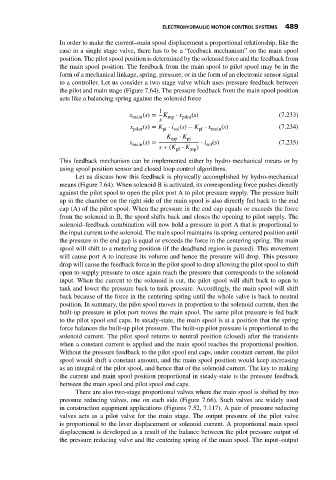Page 503 - Mechatronics with Experiments
P. 503
October 9, 2014 8:41 254mm×178mm
Printer: Yet to Come
JWST499-Cetinkunt
JWST499-c07
ELECTROHYDRAULIC MOTION CONTROL SYSTEMS 489
In order to make the current–main spool displacement a proportional relationship, like the
case in a single stage valve, there has to be a “feedback mechanism” on the main spool
position. The pilot spool position is determined by the solenoid force and the feedback from
the main spool position. The feedback from the main spool to pilot spool may be in the
form of a mechanical linkage, spring, pressure, or in the form of an electronic sensor signal
to a controller. Let us consider a two stage valve which uses pressure feedback between
the pilot and main stage (Figure 7.64). The pressure feedback from the main spool position
acts like a balancing spring against the solenoid force
1
x (s) = K ⋅ x (s) (7.233)
main mp pilot
s
x (s) = K ⋅ i (s) − K ⋅ x (s) (7.234)
pilot pi sol pf main
K mp ⋅ K pi
x main (s) = ⋅ i (s) (7.235)
sol
s + (K ⋅ K mp )
pf
This feedback mechanism can be implemented either by hydro-mechanical means or by
using spool position sensor and closed loop control algorithms.
Let us discuss how this feedback is physically accomplished by hydro-mechanical
means (Figure 7.64). When solenoid B is activated, its corresponding force pushes directly
against the pilot spool to open the pilot port A to pilot pressure supply. The pressure built
up in the chamber on the right side of the main spool is also directly fed back to the end
cap (A) of the pilot spool. When the pressure in the end cap equals or exceeds the force
from the solenoid in B, the spool shifts back and closes the opening to pilot supply. The
solenoid–feedback combination will now hold a pressure in port A that is proportional to
the input current to the solenoid. The main spool maintains its spring-centered position until
the pressure in the end gap is equal or exceeds the force in the centering spring. The main
spool will shift to a metering position (if the deadband region is passed). This movement
will cause port A to increase its volume and hence the pressure will drop. This pressure
drop will cause the feedback force in the pilot spool to drop allowing the pilot spool to shift
open to supply pressure to once again reach the pressure that corresponds to the solenoid
input. When the current to the solenoid is cut, the pilot spool will shift back to open to
tank and lower the pressure back to tank pressure. Accordingly, the main spool will shift
back because of the force in the centering spring until the whole valve is back to neutral
position. In summary, the pilot spool moves in proportion to the solenoid current, then the
built-up pressure in pilot port moves the main spool. The same pilot pressure is fed back
to the pilot spool end caps. In steady-state, the main spool is at a position that the spring
force balances the built-up pilot pressure. The built-up pilot pressure is proportional to the
solenoid current. The pilot spool returns to neutral position (closed) after the transients
when a constant current is applied and the main spool reaches the proportional position.
Without the pressure feedback to the pilot spool end caps, under constant current, the pilot
spool would shift a constant amount, and the main spool position would keep increasing
as an integral of the pilot spool, and hence that of the solenoid current. The key to making
the current and main spool position proportional in steady-state is the pressure feedback
between the main spool and pilot spool end caps.
There are also two-stage proportional valves where the main spool is shifted by two
pressure reducing valves, one on each side (Figure 7.66). Such valves are widely used
in construction equpment applications (Figures 7.52, 7.117). A pair of pressure reducing
valves acts as a pilot valve for the main stage. The output pressure of the pilot valve
is proportional to the lever displacement or solenoid current. A proportional main spool
displacement is developed as a result of the balance between the pilot pressure output of
the pressure reducing valve and the centering spring of the main spool. The input–output

